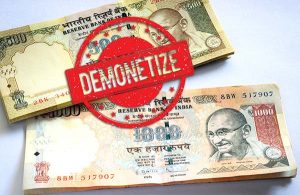
Demonetization was an effort to control black money stashed in our society. It has a very positive impact on Digital India because due of shortage of cash, people are moving towards a cashless economy. Cashless transactions means less corruption in society.
The 500 & 1000 notes used to make up about 86% of the currency in circulation by value in India and represent maximum & most popular currency denominations. This demonetization campaign has been both praised and criticized in the international media.
Demonetization acted as a catalyst, largely from urban India or more accurately banking enabled and internet enabled population which is around 35% of India’s population. Due to shortage of cash – usage of electronic means increased.
Our ministry of finance said that the purpose was to curb financing of terrorism and other subversive activities through the proceeds of fake currency notes. It also aimed to restrain the shadow economy in India, the major driver of inflation that adversely affects the poor and deprives the government of its tax revenue. It is hoped that the move will reduce cash circulation in the country, as most corrupt activities and illegal dealings are done through cash. The move is also expected to unearth people’s real income and ensure those falling under certain brackets pay taxes promptly. At present just 1% of the country’s people are paying income tax.
Until this demonitization, India was an incredibly cash-centric economy. Cash accounted for upwards of 95% of all transactions, 90% of vendors didn’t have card readers or the means of accepting electronic payments, 85% of workers were paid in cash, and almost half of the population didn’t even have bank accounts. “Cash on Delivery” was the preferred choice of 70% of all online shoppers.
By temporarily turning off the engines which drove the cash economy, India hoped that more people could be brought into the fold of Cards and e-Wallets so that it becomes trackable and taxable.
The lack of cash in the economy combined with a surge in electronic payment system has also sparked some very innovative solutions. The farmers’ markets of Telangana began experimenting with their own electronic payment system where customers with Aadhar linked bank accounts could buy vegetables using tokens which could be purchased via debit cards at specialized kiosks.
These changes indicate towards a more inclusive society in the future and more technologically advanced digital payment systems, increased merchant acceptance, improvements in UPI, which allows monetary transfers between any two bank accounts via a smartphone, as well as a reduction in cash-based transactions.
There is a strong class issue which are built into India’s cashless transition. India is a country with one foot in the future and the other in the stone age, almost literally. We have one of the most vibrant and innovative hightech ecosystems in the world along with hundreds of millions of people living in villages who are comfortable with technology that is hardly more sophisticated than a bullock cart and a plough. Only 17% of India’s population currently has access to a smartphone.
At least two places in India have already gone completely cashless. Long before this demonetization began, Auroville — a European influenced, intentionally developed “hippie” town in Tamil Nadu and the 1200 person village of Akodara in Gujarat have already eradicated cash in exchange for electronic payment systems.